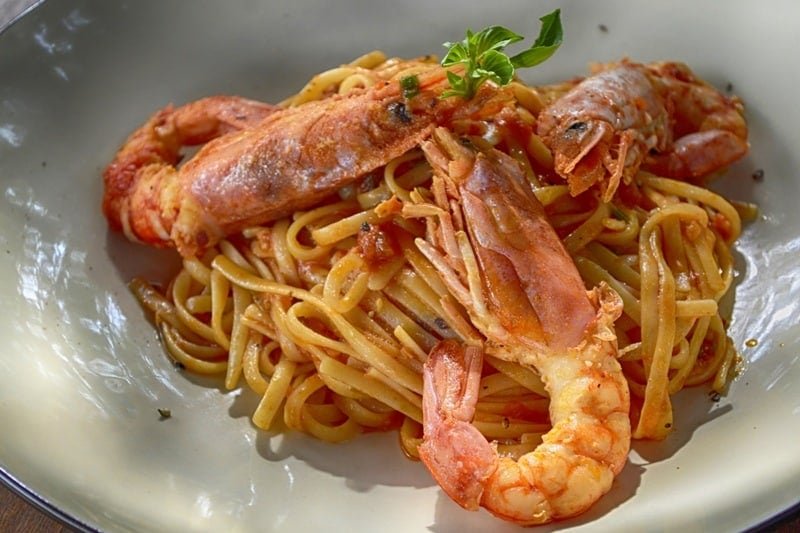
If there is one dish that truly captures the essence of a Greek summer, it’s shrimp pasta. Beyond its captivating flavor and impressive presentation, there is a culinary science behind its success.
From the chemical reactions that build a rich bisque to the precise timing for a perfect al dente texture, this dish is a delicious lesson in the art and science of gastronomy.
Shrimp pasta: A symphony of proteins and seafood aromas
Shrimp are an incredibly delicate ingredient, with proteins that are highly sensitive to heat. At an optimal temperature of around 85°C, their muscle proteins coil and solidify, creating that signature firm, yet juicy texture. Exceeding this temperature will cause the proteins to dehydrate excessively, resulting in a rubbery texture. This is why shrimp should always be added to the sauce at the very last minute, ensuring they retain their pleasant bite and subtle sweetness.
Meanwhile, the shrimp heads and shells are small culinary laboratories in themselves. They contain a treasure trove of amino acids, sulfur compounds, bromophenols, and protein macromolecules that provide the deep, marine aroma crucial to a great sauce. Sautéing them over high heat releases volatile compounds like dimethyl disulfide and pyrazines, which contribute a powerful umami flavor.
The reactions between sugars and amino acids during this process also add a layer of complex depth and intensity. When the heads and shells are then mashed and strained, they create a thick, flavorful broth—a bisque—that becomes the heart of the dish, elevating every bite.
The al dente miracle: Pasta science
Pasta, too, demonstrates the power of precision. As it cooks, the starch granules swell with water, held together by an insoluble network of proteins. This network is what gives pasta its structure. If cooked for too long, the granules break apart and release excess starch, causing the gluten to collapse.
However, when the cooking is stopped just before this point—what the Italians call al dente—the starch has swelled in a controlled manner while the protein structure remains intact. This not only provides a satisfying resistance to the tooth but also allows the pasta to correctly absorb the liquids and aromas of the sauce.
The sauce: Caramelization and the anise kiss of ouzo
The sauce is the essential binder that brings all the elements together. Caramelizing the tomato paste at the beginning enhances its natural sugars, creating a rich sweetness and depth.
The addition of ouzo, with its distinct anethole flavor, acts as a culinary bridge, connecting the sweetness of the shrimp, the acidity of the tomato, and the richness of the olive oil. Over high heat, the alcohol quickly evaporates, leaving behind only the complex, aromatic notes of anise and herbs—a flavor that feels distinctly Mediterranean.
Finally, fresh herbs such as parsley, basil, and thyme are added right at the end to preserve their delicate volatile compounds. These vibrant notes provide a fresh, final balance to the dish’s deep, savory summer flavors.
Expert tips for the perfect Greek shrimp pasta
To achieve the best possible shrimp pasta, a few scientifically-backed tips are key:
Finish the Cook in the Sauce: Boil the pasta two minutes less than the recommended time and finish cooking it directly in the sauce. This allows the pasta to absorb the flavors while maintaining that perfect al dente texture.
Don’t Waste the Shells: Always use the shrimp heads and shells to create a broth, pureeing them for maximum extraction of flavor compounds.
Build the Base: Caramelize your tomato and paste well to create a rich, flavorful foundation for the sauce.
Keep it Tight: Use a limited amount of liquid to prevent the sauce from becoming watery.
Time the Shrimp: Cook shrimp for no more than 2-3 minutes, adding them at the last moment to ensure they remain juicy.
The Final Touches: Finish with a drizzle of fresh extra virgin olive oil and freshly chopped herbs to complete the sensory experience.
Shrimp pasta is a testament to the idea that science and art can beautifully merge. Each bite is the result of a series of precise chemical reactions and the careful management of texture and aroma—all coming together to create an unforgettable taste of summer.
Related: Shrimp And Gyros Skewers: Where The Mountains Meet The Sea


